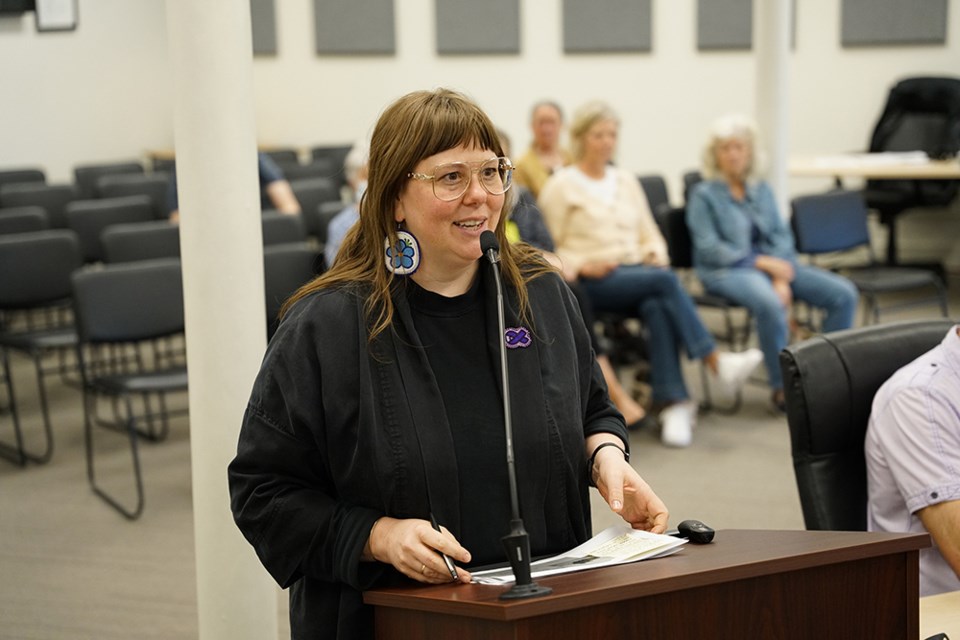City of Powell River councillors received an overview of the activities of the qathet Community Action Team (CAT) since its inception.
At the city council meeting on April 4, Kathryn Colby, CAT coordinator, said the team had been receiving funding from the provincial government and working in the community since 2018. She said it is now nearing the seventh anniversary of the declaration of the public declaration of the health emergency associated with the overdose crisis.
“Our community has been more hard hit than many places in British Columbia by the overdose crisis,” said Colby. “I’m here to share the work we’ve done together since 2018.”
The crisis affects families, and primarily men, in this region, said Colby. Between 2017 and 2019, Powell River had consistently the second highest illicit drug overdose rate per population in the Vancouver Coastal Health region, according to Colby.
“We became a community of interest for the provincial government due to the alarming per capita rate of accidental overdose deaths in our region,” said Colby. “We bounced between the second and seventh highest illicit drug overdose death rate in British Columbia, according to the BC coroner. We remain a community of interest. We still continue to have the highest rural area per capita of accidental deaths in British Columbia.”
Colby said when talking about drug use, there is often an association with marginalized people, people on the street and criminalized homeless people, but those most affected by the death rates are men in their 40s and older, men who have a history in the trades, plus Indigenous women, ages youth to middle age.
“Honestly, it could be anyone, at any time, trying drugs for the first time,” said Colby. “According to our community, the vulnerability to overdose deaths may be a response to chronic pain and/or stigma to seeking help. Fentanyl and its analogs can be found in any substance in any amount.”
Colby said the CAT is working with the BC Centre on Substance Use on a three-year research project to get to the roots of why, in this small, rural area, deaths continue to happen despite best efforts.
“With that research we’re hoping there will be recommendations on getting rural-specific treatment for folks.”
Saving lives
Colby said fentanyl deaths were seen for the first time here in 2016. She said in 2017, there was a community fentanyl forum. It was a public and shareholder meeting to get people working together to identify and to try to stop the accidental deaths, according to Colby.
“Because in 2017 we became a community of interest, in 2018, we were one of 17 communities that received $100,000 from the Overdose Emergency Response Centre, which is directly connected to the ministry of mental health and addictions,” said Colby. “We brought leaders and shareholders together to see what we could do. The direction was saving lives right now, offering safer alternatives and offering early intervention.
“What we know is the antidote to this crisis is connection. When we stigmatize and make it hard for people to find the treatment they require, they don’t recover.”
Colby said in 2019, the CAT, which still operates the overdose prevention site, opened the first local prevention site. In the first three months, there were more than 550 visits to use drugs onsite.
“We didn’t know if anyone would come; it turns out a lot of people came,” said Colby. “We created more than 15 jobs in the community that carry on to this day. We’ve referred countless folks to health care. We’ve connected people to pharmaceutical alternatives, and we’ve since moved to a private location.
“Since the time that we’ve moved, we’ve reversed hundreds of overdoses and not a single person has died at the overdose prevention site.”
Colby said assistance has been provided to get many people to treatment and people have been directly connected to health services.
In 2021, a local injectable opioid agonist therapy clinic opened, where people can go directly to use prescribed medications to stop their illicit drug use, said Colby, and this is the first rural example of this.
“We continue to be leaders,” added Colby. “This clinic is in a standalone space for people seeking medical treatment for substance use."
In 2022 the youth community action team was created, which gave youth space to share their concerns about substance use in the community. It was also the first year that a Powell River youth died from poisoned illicit supply, according to Colby.
“Everything we do at the CAT level has a deeper value because it’s one of shared effort in our community,” said Colby. “We are seen as a leader, both provincially and nationally.”



